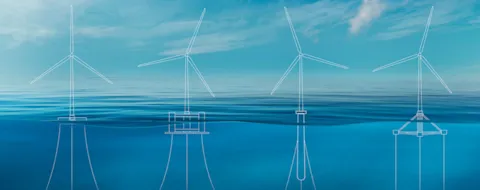Optimizing mooring and dynamic cable design requirements for floating wind
New joint industry project
DNV is launching the Floating Wind Reliability joint industry project (JIP) aiming at optimizing design requirements for mooring and dynamic inter-array cable systems applicable for commercial scale floating wind projects. The JIP will provide new and vaulable insights on load and capacity of these critical components and the recommendations will form basis for tomorrow’s design requirements.
Background for the JIP
The global energy system will see a rapid transition towards renewables, and offshore wind will be a key ingredient in the mix. According to DNV’s predictions, offshore wind will alone account for 25% of all electricity generation in Europe in 2050. Floating wind at scale will be required to make use of offshore areas in deeper waters to meet the high ambitions. Across several different regions in the world, we see that governments are announcing new lease areas for floating wind, and to deliver on target cost all parts of the project development need optimization. Fortunately, the development within floating wind is fast, and the feedback from the industry is that optimized, calibrated, and aligned requirements for design of floating wind mooring and dynamic inter-array cables are needed now.
“Floating wind will provide access to abundant wind resources and will in many regions be required to deliver on the defined ambitions for offshore wind. By launching the Floating Wind Reliability JIP, DNV aims at supporting the industry in developing and certifying floating wind in a cost-efficient manner without compromising on the required safety,” said Ditlev Engel, CEO of Energy Systems at DNV.
Making floating wind commercially viable
To enable the cost reductions needed to make floating wind commercially viable, it is important that the design requirements are optimized. The mooring and dynamic cable system are critical components in a floating wind farm, both to ensure the integrity of the structures and to ensure production availability.
The dynamic cable system and lack of optimized acceptance criteria is a challenging part of floating wind design. Today’s requirements are mainly based on requirements for similar type of structures (e.g. umbilicals), which are not necessarily representative. Calibrating utilization factors for cables based on combined tension and curvature response and design fatigue factors for the cables will be an important part of the work in the JIP. Furthermore, guidance on a holistic and simplified methodology that can be used in the early cable system design process is lacking in today’s rules and regulations and will be addressed.
For mooring, the design needs to accommodate the high loading (extreme and cyclic/fatigue loading) imposed from both operational and idling conditions and ensure compliance with cable offset requirements. Improved mooring design methodology and optimized safety factors will be recommended based on the findings in the project.
The work will form basis for updating standard DNV-ST-0119 Floating wind turbine structures enabling cost-optimized mooring and dynamic cable designs. Furthermore, alignment of requirements and procedures will provide a reliable basis for design and certification of commercial wind farms, improved predictability for developers, designers, component manufacturers. Investors, lenders, insurance companies and authorities will take advantage of up-to-date requirements which will positively impact project safety, availability, cost and schedules.
Optimizing design and methodology
The Floating Wind Reliability JIP is initiated to establish consistent design philosophy and analysis methodologies for design of mooring and inter-array cable systems optimized for commercial-scale floating wind applications. The ambition is to provide cost-efficient design requirements without compromising on safety.
The work will build on a probabilistic approach applying state-of-the-art coupled time-domain analysis to evaluate the reliability level and re-calibrate safety factors for mooring and cable design. It will, for a confined set of cases, address the design for Ultimate Limit State (ULS), Accidental Limit State (ALS) and Fatigue Limit State (FLS) of mooring lines and inter-array cables, with objectives:
- Evaluate cost-optimal reliability/safety level(s) for mooring and inter-array cable systems
- Establish overall design philosophy and corresponding analysis methodology
- Apply structural reliability analysis and calibrate optimized safety factors for target reliability level given the defined analysis methodology. The mooring line tensions, cable tension and curvature responses will be based on coupled time domain simulation across a range of relevant designs and locations (environmental conditions and water depth).
Why join this JIP?
As a participant in the Floating Wind Reliability JIP you will be able to:- Directly influence and help shaping optimized design requirements for mooring and dynamic inter-array cables for floating wind – applicable for the first wave of commercial-scale farms
- Obtain early knowledge on what to expect of future design requirements, before they are published
- Obtain valuable insight and data on cost models, load models and capacity models
- Obtain valuable insight on mooring and cable integrated performance and design drivers
- Get access to expert forum for sharing knowledge, networking and learning.
